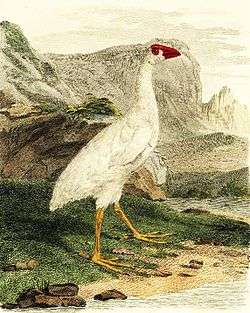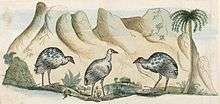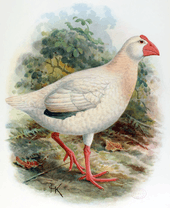Lord Howe swamphen
| Lord Howe swamphen | |
|---|---|
 | |
| From Journal of a Voyage to New South Wales by John White | |
| Scientific classification | |
| Kingdom: | Animalia |
| Phylum: | Chordata |
| Class: | Aves |
| Order: | Gruiformes |
| Family: | Rallidae |
| Genus: | Porphyrio |
| Species: | P. albus |
| Binomial name | |
| Porphyrio albus (Shaw, 1790) | |
| | |
| Location of Lord Howe Island | |
| Synonyms | |
| |
The Lord Howe swamphen or white gallinule (Porphyrio albus) was a large bird in the family Rallidae endemic to Lord Howe Island, Australia.[1] It was similar to the purple swamphen, but with shorter and more robust legs and toes. Its plumage was white, sometimes with a few blue feathers, and it was probably flightless, like its other close relative the takahe. Similar, entirely blue birds were also described, but it is not clear if they belong to this species or are simply purple swamphens (which can also be found on the island). The feathers on the two extant skins are white.


This bird was first described by John White in his Journal of a Voyage to New South Wales (1790),[2] which also contained an illustration. It was not uncommon when the bird was first described, but was soon hunted to extinction by whalers and sailors.
There are two skins of the bird in existence, one in the collection of the World Museum in Liverpool and the other in the Naturhistorisches Museum Wien in Vienna. There are also several paintings, and some subfossil bones.
See also
References
- 1 2 BirdLife International (2012). "Porphyrio albus". IUCN Red List of Threatened Species. Version 2013.2. International Union for Conservation of Nature. Retrieved 26 November 2013.
- ↑ White, John (1790), Journal of a voyage to New South Wales with sixty-five plates of non descript animals, birds, lizards, serpents, curious cones of trees and other natural productions, London: J. Debrett, also at Project Gutenberg Australia
